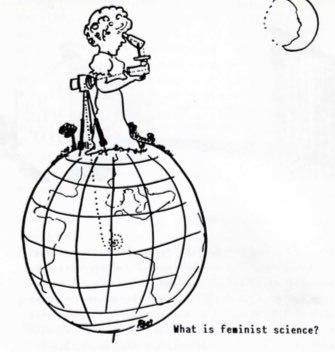
By Bettina Berch
I have not come to present a list of strategy recommendations. I conceive my function differently: I am trying to make some remarks that will make it possible for us to discuss strategy, hopefully in a new light. So I will try to provoke you a little, perhaps talking more about the process of strategizing, rather than endorsing particular strategies.
First, we must recognize the difficulty of constructing strategy when our theoretical perspectives are still so unclear. Then we must remember that feminist strategy is more about process than targets. We know more about how to develop understanding among each other than what to do about our understandings. Feminist process is usually about correct means of relating to each other, and demystification as a project in itself. We don't tend to put much emphasis on what we would want if we had the power to institute it, and how those desireable ends would really be accomplished.

I want to emphasize certain key theoretical insights into what New Technology is about, some crucial demystifications, before moving to strategy. New Technology is promoted as gender-neutral. It is thus made to seem benign, even to women's movement advocates. We are told that the Machine, at least, is gender-blind, it doesn't care who uses it ... New Technology is promoted as inevitable and thus it is made to seem indisputable, undiscussable... To the extent that people react to the idea of New Technology, they seem to take one of three approaches. They are eitherutopic ( Toffler, for example) or dystopic (Or well's nightmare) or say that" it could be either" — agnosticas to which will occur, as both are possible. Are we in this latter category, especially when we try to ask — "what could be the good things about this technology for women?" The mere idea that it could have positive aspects, however, forgets that New Technology bears the imprint of its makers. Its designers have not forgotten the racism, sexism, and classism of their own highly profitable system when they designed this new generation of technology. And they did design it - it didn't drop from heaven, or unfold naturally from the existing structure of technology.
•lost discussion of the introduction and use of new technology also rests on the myths of pluralism and democracy. A "we" is assumed, some integrated society, where all experience similar effects of New Technology. We are made to think that we're all going to lead more amusing and profitable lives with new technology. Or that even i f our access to these "benefits" isn't equal—because we are women and math-phobic, for example, or poor and have no money to purchase access to new tech, or because we are from developing countries without these resources— then we could be susbsidized in to participation. Women could get math training, the poor could get access through public facilities, developing countries could buy access with loans from the first world...
But what is this equality to be about?
It is about equal access to information, to work, that reinforces, if not deepens, existing divisions between those who control the production and distribution of information and products, and those who don't.
What are the unspoken aims of New Technology? One aim i s to turn information into private property that can be bought and sold for a profit. A second aim is to move forward the process of the degradation of human work. In the first industrial revolution, the Taylorization and Fordism, we experienced the degradation of human dexterity. In this next wave of new technology we experience the degradation of the use of the human brain. A third aim is to transform what we have known as private life/ public life into "audience life". We are to be delivered to those who sell commodities as an audience. And remember, the biggest vendor of commodities, worldwide, is the military-industrial complex.
Given these perspectives, what types of strategies are possible? We have some familiar tactics, which are important to emphasize. We must continue the struggle for equal pay and affirmative action in employment, since as women our basic economic powerlessness still means we suffer the worst consequences of the new technology. We must continue the struggle to organize workplaces, with union is strength. We have to publicize the health hazards of new tech, especially as that is an effective means of mobilizing opposition. We may be able to target some of the worst corporations for censure, particularly with respect to multinationals operating in the Third World. We must continue to construct our information dossiers, and transmit this information to any forums available.

Then there are the less familar tactics. In some industries, workers have been demanding a "Technological Bill of Rights" that would give them a structural role in the planning and implementation of any new technology at the workplace, as well as a grievance procedure for problems, and job guarantees. International conferences, such as this one sponsored by ISIS, are extremely useful for making our international links stronger. Theater can be a very important tactic, especially productions such as the one done by Barbara Garson, The Department, which was written with office workers, acted by them, and watched by them as well as the general public. Remember that many women do not have the time or resources to attend marathon conferences like this, but many can go out to an entertaining and pointed show in the evening. The same holds for films with a critical understanding, especially films that can be produced with the new, cheaper technology of video, and our old friend, the radio. In many cities , there are women's radiostations or "alternative" stations that reach a wide range of people. Or we may try to break out of old patterns of communication and broad cast from workplaces, for example. Some feminists have been using science fiction as a mode of exploration of "desireable feminist futures". This is a creative means of breaking out of the passivism engendered by contemporary culture, allowing the imagination to find new life possibilities. It has become more important than ever to explore new modes of cooperative living, especially give n the threat of isolation inherent in the new "electronic cottage" scenario.
After thinking about these types of tactics, I began to wonder whether our notions of tactics were also somewhat mystified. I thought about a quote I read from Dallas Smythe: "Recall that the overthrow of the Shah of Iran required no more equipment than cassette tapes, the telephone and Xerox, which together with mosques, festivals, meetings, and the bazaar, did the trick. "Perhaps it is time for feminists to mobilize some of the tactics of low-tech revolt.

Let us examine, for a moment, the mystification of strategy itself. We feminists have patterned our notions of fighting the system after a model that those in power have given us. They give us the metaphor of the chess game for this battle over how our futures are going to be determined. In chess, both sides start out even, both sides use the same rules, and the most clever player wins. We have tried to wage the feminist struggle with this concept of battle for a long time. We have to realize that we are not playing an equal game, and we are not really playing with the same rules.

How did the ruling class get their power? They have employed major mystifications of what their culture is about. They promote a work ethic, even though they actually work very little. They promote individualism, even though we know we all live or die on this planet together. They celebrate the power of abstraction , and devalue daily real needs, that which women have always been careful of. Apart from these key mystifications, they gained their power by violence against the Other — especially women and third world people. (Apparently they can't afford to use such violence against their own, as it would alienate the moral patience. Thus advertising is used on the domestic middle class...)
Given these thoughts, I began to think about more appropriate strategy, given the type of struggle we're engaged in, and given the stakes we're playing for. Remember, when we speak of New Technology, we are also speaking of nuclear destruction-laser wars in space - basic threats to the survival of the planet. I decided to mention the unmentionable: sabotage.
I have discovered that the mere discussion of what sabotage might imply is a very refreshing, even liberating thought. Remember, many of us still have notions of sabotage left over from the turn-of-the-century— molotov cocktails and all that. From talking to different types of workers, I have found a wide range of tactics being deployed. For example, I work as a university professor. For me, sabotage is to teach my students about the certification process of education, to demystify the value- free guise of elitist western higher education. Secretaries have told me of ways they right their typewriters so they get a three hour break from their typing, while waiting for the repair person. Word processors describe spilling coffee or sugar onto the control panels of their terminals. Floppy discs are mislabelled,
tapes "accidentally" erased.
We also need to develop alternatives to the way of life they've designed for us. We have to remember that the media haven't created false needs, as much as exploiting some of our very real needs. Whatever we might suggest has to take people's real needs and wants seriously.
We need to emphasize that our project is the project of TAKING BACK THE FUTURE. In the words of one of my favorite writers, Toni Cade
Bambara, "In whose name will the twenty-first century be claimed?"
MOTHERS OF INVENTION

Zubayda (c.780-820) was the wife of one Muslim Caliph and mother of another. She acted as their regional and city planner and was responsible for rebuilding Alexandr etta after its destruction, and for building an aqueduct to Mecca.
Catherine Little field Green (late 18th cen.) invented the cotton gin in 1793. Since it was in conceivable for a woman to apply for and develop a patent, she showed her invention to Eli Whitney, who got the patent, money and credit for the invention that revolutionised agriculture in the American South.
Aaanda Theodosia Jones (1835-1914) was an author, inventor. She obtained numerous patents for innovations in food processing and canning. She founded and incorporated the Women's Canning and Preserving Company in Chicago in 1890. She also patented an oil burner.
Sybilla Masters ( d.1720) obtained two patents, both in her husband's name, for her inventions. One was a new process for stamping rather than grinding corn, and the other a process for making hats, bonnets, baskets and mats out of straw and palmet to leaves. She and Amanda Jones are not able in their attempts to manufacture and market their own inventions.
Margaret E. Knight (1838-1914) had inventions which ranged from a clasp for hold in grobes, to rotary engines. She i s known for developing the process and the machines that makes the square bottom paper bag. She is unusual among women inventors both for the number of her inventions, and for the fact that so many of them concerned heavy machinery.
Rebecca Lukens (early IQth cen.) became the first woman iron worker and metal lurgical engineer when she took over management of the Iron Works at her husband's death, pulling them out of a state of bankruptcy and fulfilling contracts previously behind schedule, while establishing a strong business selling plate for machinery. She moved to steel production and supplied the boiler plate for the first metal hulled vessel constructed in the US. Betsy Ann Stearns (b 1830) designed a method by which she could cut her own and her daughters' dresses. In 1864 her first invention for dress and pattern cutting was made. She received a silver medal and diploma from the Massachusetts Mechanical Association and the highest award for its accuracy, simplicity and economy from the Academy of Inventors Member d'Honneur, with a diploma and gold medal.
ILO CONFERENCE
Krishna Patel, editor of "Women and Work" at the ILO, spoke to the conference about what was being discussed that particularly concerned women at the ILO Conference, running concurrently. The participation of women in all sectors of the economy was discussed in two committees.
The Committee on Employment Policy acknowledged the fact that although there are many international declarations on women's equal right to work, and that women make up more than 50% of the world's population, the number who have paid employment is very low. It reviewed corrective measures taken by member states to implement the right to equality of opportunity and treatment of women but did not suggest any ways in which women's participation might be further encouraged.
It was left to the Committee on Social Aspects of industrialisation to acknowledge the special difficulties and discrimination that women are subjected to. There is now more awareness that women are the most economically vulnerable and that existing social facilities and services are in adequate to meet the needs of the large numbers of women who have entered the labour force. But no mention was made of the fact that women may be deterred from entering the labour force and that often they cannot be registered as unemployed. Nor was there any recognition that women specially need technical education and training in order that they will be able to compete success fully for employment in the future .

